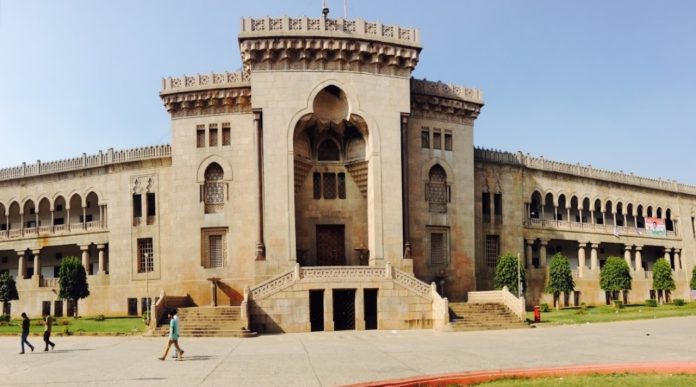Osmania University has since evolved into the largest university in India, affiliating with around 1,000 colleges and accommodating approximately 550,000 students.
– Abdul Wahed
Osmania University, once a focal point of statehood agitation, now witnesses a shift in priorities among its students. During the final phase of the statehood agitation, students played a key role in protests that led to the passing of the Andhra Pradesh Reorganisation Bill in January 2014.
In the aftermath of those events, K Chandrashekar Rao, a prominent figure in the Telangana movement, became Chief Minister after winning the subsequent elections. However, the initial nostalgia for KCR’s role in the agitation has diminished among Osmania students. They now grapple with issues such as the frequent cancellations of government recruitment exams, the increasing maximum age limit for many of these exams, a scarcity of job opportunities, a perceived restriction on the expression of dissent, and challenges related to the university’s infrastructure.
Interestingly, the sentiments on Osmania campus are reflective of the broader public mood, evident in the resurgence of the Congress party, which has doubled its vote share, according to exit polls. To comprehend Osmania University’s significance, it’s essential to delve into its history – from the days of the erstwhile Hyderabad state to its current role in Telangana.
Osmania University’s history intertwines with the events of the Hyderabad State, witnessing moments of turmoil, including the Hyderabad State merger, local employment movements, the Telangana struggle, and more. The university, with its roots deeply embedded in Muslim heritage, has consistently emphasized cultural diversity, evolving into a hub of modern education conducted in the English language. Jamia Osmania has achieved numerous milestones over its extensive journey.
Osmania University holds the distinction of being the first university in India to adopt Urdu as the language of instruction. During its establishment, no Indian language was used as a medium of instruction in any university across the country. Celebrating its centenary in 2017, Osmania University stands as one of the country’s most esteemed institutions, seamlessly merging tradition with modernity.
Noteworthy figures such as former Prime Minister P.V. Narasimha Rao, India’s first astronaut Rakesh Sharma, filmmaker Shyam Benegal, former RBI Governor Y.S. Venugopal Reddy, Magsaysay award winner Shanta Sinha, and Dr. Marri Chennareddy are among the distinguished individuals educated at Osmania University.
Established by the seventh Nizam of Hyderabad, Mir Osman Ali Khan, on April 26, 1917, Osmania University stands as one of the oldest universities in India and the third in South India. Sir Akbar Hydari, serving as the Home Secretary to the Government, advocated for the university’s creation, emphasizing Urdu as the language of instruction. This marked a departure from the prevailing trend of English being the sole medium of instruction in the country.
The Nizam’s decree outlined the university’s objectives, calling for a holistic education blending ancient, modern, oriental, and Western knowledge. It stressed Urdu as the medium of instruction, with compulsory learning of the English language.
The decision to teach in Urdu was fueled by patriotic sentiments following the World War-I and the 1857 War of Independence. Nobel Laureate Rabindranath Tagore commended the effort to break free from foreign language constraints in education. Sir Michael Sadler, a prominent British academic, also praised the initiative.
Classes at Osmania University commenced at the Gun Foundry in 1919, using various locations until the campus was established in 1934. The journey began at the Gun Foundry, where renowned figures like Makhdoom Muhiyuddin, a prominent Urdu poet involved in the Telangana armed struggle, studied.
Osmania University initially offered courses in Arts and Theology with only two departments, catering to 225 first-year students. Courses were offered in Sanskrit, Telugu, Kannada, Marathi, Persian, Arabic, and Urdu, with English as a mandatory language. In 1934, the university acquired 566 acres, and the Arts College building, an architectural marvel, was completed in four years.
Urdu served as the language of instruction across various disciplines, including medicine, engineering, undergraduate, postgraduate, and PhD programs. The university conducted a large-scale translation program for textbooks, challenging the prevailing notion that Urdu was solely the language of Muslims.
Post the merger of Hyderabad State into the Indian Union in 1948, English replaced Urdu as the language of instruction. Osmania University has since evolved into the largest university in India, affiliating with around 1,000 colleges and accommodating approximately 550,000 students. The university offers distance education, boasting 12 faculties, 53 departments, 25 undergraduate programs, 75 postgraduate programs, and a diverse community of foreign students.
Osmania University has played a pivotal role in various movements, such as resisting the shift to the Hindi medium in 1952 and advocating for local employment opportunities. The Telangana movement, marked by violence, had Osmania at its center. Osmania University, a witness to Hyderabad’s cultural and political evolution, proudly stands as a symbol of Hindu-Muslim harmonious culture.




